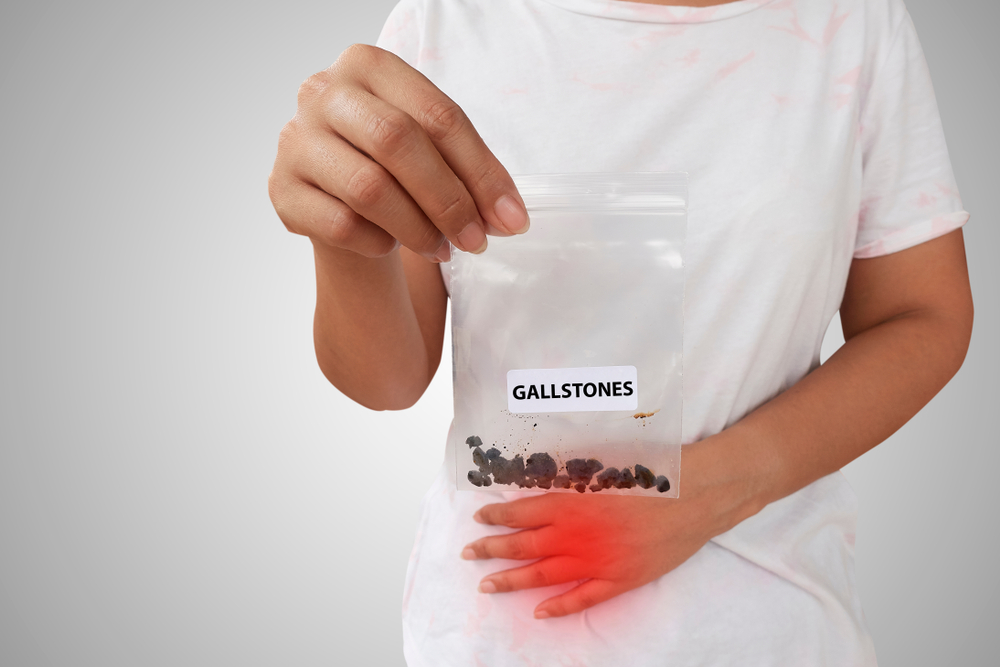Are you experiencing acute pain in your upper right abdomen?
This may be an indication of gallstones.
Are you experiencing acute pain in your upper right abdomen?
This may be an indication of gallstones.
What are gallstones?
Gallstones are hardened cholesterol or calcium deposits that form in the gallbladder and can lead to acute pain in the upper right abdomen.
You may also have an increased risk of developing gallstones in your gallbladder as a result of bile—a liquid secreted by the liver.
According to statistics, 80% of the stones found in the gallbladder are formed by an excess of cholesterol in bile, which can occur if the liver produces more cholesterol than the bile can dissolve.
In other instances, stone formation can be attributed to an excess of calcium salts and bilirubin in the bile.
You may also develop stones in your gallbladder if the organ fails to empty and the bile becomes concentrated.

What are gallstones?
Gallstones are hardened cholesterol or calcium deposits that form in the gallbladder and can lead to acute pain in the upper right abdomen.
You may also have an increased risk of developing gallstones in your gallbladder as a result of bile—a liquid secreted by the liver.
According to statistics, 80% of the stones found in the gallbladder are formed by an excess of cholesterol in bile, which can occur if the liver produces more cholesterol than the bile can dissolve.
In other instances, stone formation can be attributed to an excess of calcium salts and bilirubin in the bile.
You may also develop stones in your gallbladder if the organ fails to empty and the bile becomes concentrated.




What are gallstones?
Gallstones are hardened cholesterol or calcium deposits that form in the gallbladder and can lead to acute pain in the upper right abdomen.
You may also have an increased risk of developing gallstones in your gallbladder as a result of bile—a liquid secreted by the liver.
According to statistics, 80% of the stones found in the gallbladder are formed by an excess of cholesterol in bile, which can occur if the liver produces more cholesterol than the bile can dissolve.
In other instances, stone formation can be attributed to an excess of calcium salts and bilirubin in the bile.
You may also develop stones in your gallbladder if the organ fails to empty and the bile becomes concentrated.




Symptoms of gallstones
In most cases, the stones in the gallbladder do not have any symptoms at all, which is why it’s sometimes called “silent gallstones”. In fact, 80% of patients are asymptomatic when it comes to stones in the gallbladder.
As a result, you may experience acute pain in the upper right abdomen, which may start after the consumption of fatty food, if the stones block the bile ducts that regulate the flow of bile between the live and gallbladder. The pain may last a few hours.
Patients may also experience the following symptoms:
Nausea and vomiting
Dark urine
Excessive burping
Nausea and vomiting
Dark urine
Excessive burping
Abdominal pain
Diarrhoea
Indigestion
Abdominal pain
Diarrhoea
Indigestion
Diagnosis
If you notice any of the symptoms outlined above, you need to consult a gastrointestinal specialist. They may perform a physical examination and check your eyes and skin for colour changes, which may occur if there is too much bilirubin in the body.
You may also need to undergo a blood test to identify the level of bilirubin and cholesterol in your body.
In addition, you may be subjected to several scans including abdominal CT scans, gallbladder radionuclide scans and ultrasound scans to detect the existence of stones in the gallbladder.
Do gallstones go away on their own?
In the majority of cases, gallstones may not require any treatment unless they block bile ducts and cause pain. In certain instances, you may even pass stones without realising it.
You can also treat gallstones by altering your diet after consulting your doctor.
In more severe cases, your doctor may recommend laparoscopic surgery, which can be completed within a day, to remove the gallbladder.
If you are unable to go through a surgical procedure to remove the gallbladder, you may be administered oral medication.
FAQ
What may acute abdominal pain in the right upper quadrant signal?
The differential diagnosis of right upper quadrant abdominal pain is broad including liver and gallbladder disorders, diverticular disease, inflammatory bowel disease, pancreatic disorders, pyelonephritis, nephrolithiasis, pulmonary disorders and malignancy.
What causes acute upper abdominal pain?
Other possible causes include:
1.Liver disease. Pain in your liver is usually from inflammation (hepatitis), which has many causes, both chronic and acute. …
2.Pancreas diseases. …
3.Stomach diseases. …
4.Intestinal obstructions. …
5.Enlarged spleen. …
6.Upper urinary tract and kidney diseases. …
7.Peritonitis. …
8.Heart and lung conditions.
What organ is on your upper right side that can cause pain?
The right upper quadrant of the ribs covers the pancreas, right kidney, gallbladder, liver, and intestines. Pain under the ribs in this area can indicate a health problem affecting one of these organs.
What does pain in your upper right abdomen mean?
Upper right abdominal pain can be caused by various factors such as gallbladder disease, liver problems, pancreatitis, gastrointestinal issues, or muscle strain. A thorough medical evaluation is necessary to determine the specific cause.
Schedule an appointment with gastrointestinal specialists
The team of specialists at the Sydney Gut Clinic are trained and experienced in treating a range of gastrointestinal conditions including gallstones.
Consult our specialists if you notice any of the symptoms listed above.
Sydney Gut Clinic services are only available to patients in Australia.
